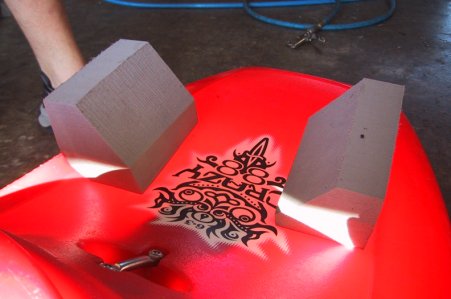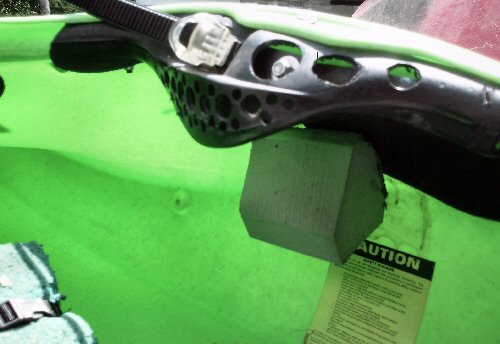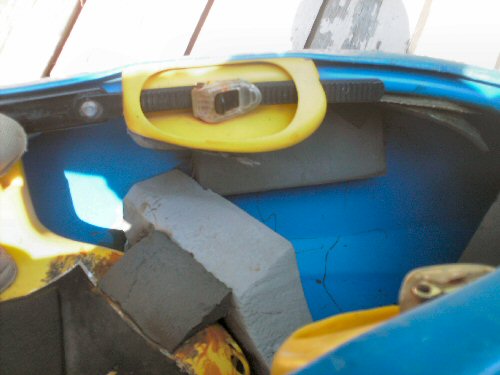Thigh Braces
Braces to the outside of your thigh are the single biggest improvement
that you can make to the stock outfitting
of a play boat. As you make an aggressive reach with your paddle (like
for a stern squirt or a cartwheel) your
torso will twist and the leg on the opposing side of your body will
attempt to go straight. These blocks will keep
your lower body from shifting when your upper body is wound up. The end
result is more torque. Also when you are
relaxing, your knees can fall outward and come to rest on to the pads
reducing fatigue.
With most whitewater boat cockpits being quite deep you will glue high on the inside of the side wall. You will need a pad high enough to be snug against your knee so that your knee will hold an unglued pad in place as you sit in the boat.
A good starting point for a shape is a triangle. An updside down hip pad also works well.
Below is a picture of the desirable shape which is in between being the shape of a triangle or an upside down hip pad.

To achieve the fit sit in the boat and place the pad in place on the outside of your knee and then trace with a heavy pen. Get out of the boat and glue in place ever so slightly higher then where your marks would indicate. Your pen marks will not make it into the exact corner and it is also much easier if you end up making the pad to snug than too loose. Once glued in you can sand it down to fine tune the fit. If you end up with it too loose you can fix it by gluing a piece of 1/4 or 3/8th thick foam over the top of the piece.
Here are some examples of the thigh blocks in place.

Dagger Kingpin 6.3. This is a very typical placement. For most people the pad will be in roughly this area and about this size.

Liquid Logic Space Cadet. This is not a very typical outfitting job but it may give you some ideas. The thigh risers built off of the seat and hull aren't completely necessary but do give some additional support .
The thigh pad here is quite long at over 7". Width this boat the cockpit feels a little lower making the knees not as high in the cockpit.
The longer pad seemed to work nice in this situation as a large portion of it does actually contact the outside of the knee.
_________________________________________________________________________________________________
Originally this techingue was done by gluing blocks
to the hull and is no longer the preferred method.
Despite one manufactures claim to have invented this
concept, these have been used in slalom
boats for years. I first saw them in Eric Jacksons slalom boat in
1997. That same year squirt boaters like MarkTravis started using them
and play boaters soon followed.
We have still included info on that method here though because it can be a better way to go for a lower volume cockpit area. The dimensions of the blocks used in these pictures are a 3" piece cut 9" across and 5"high. The cut on the top corner is to ease entry and exit of your ankles. For this cut about 2" down and 3" across. The only advantage of making the block wide like you see in these pics is to inhibit them from rippingout. A bigger surface area to glue will make them stronger.
If you wish to make your blocks less likely to obstruct exit then the
method in the next section further downthis page.
|
Click the image to see it larger then back on your browser to come back here |
Click the image to see it larger then back on your browser to come back here |

